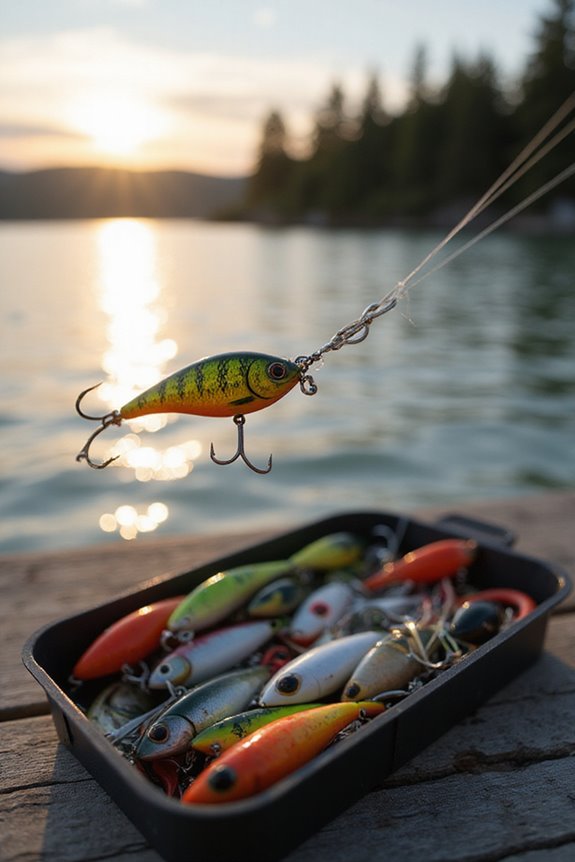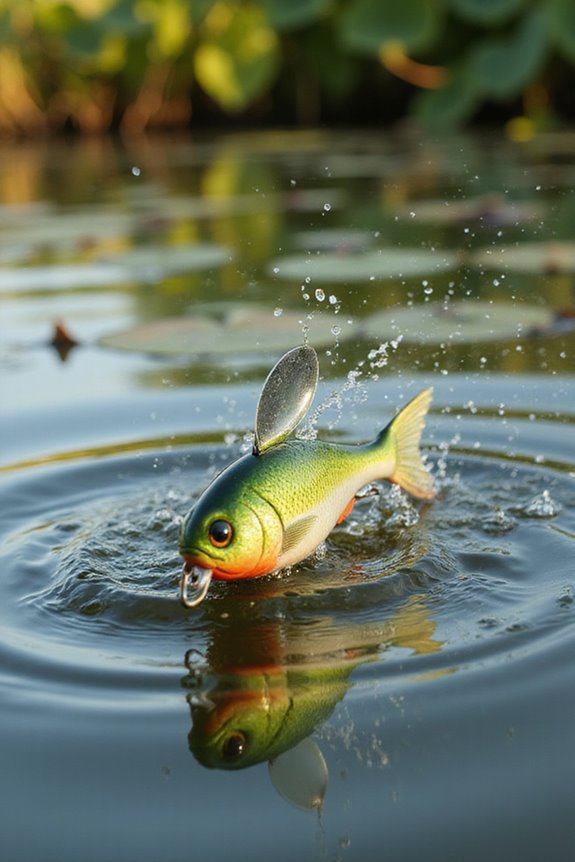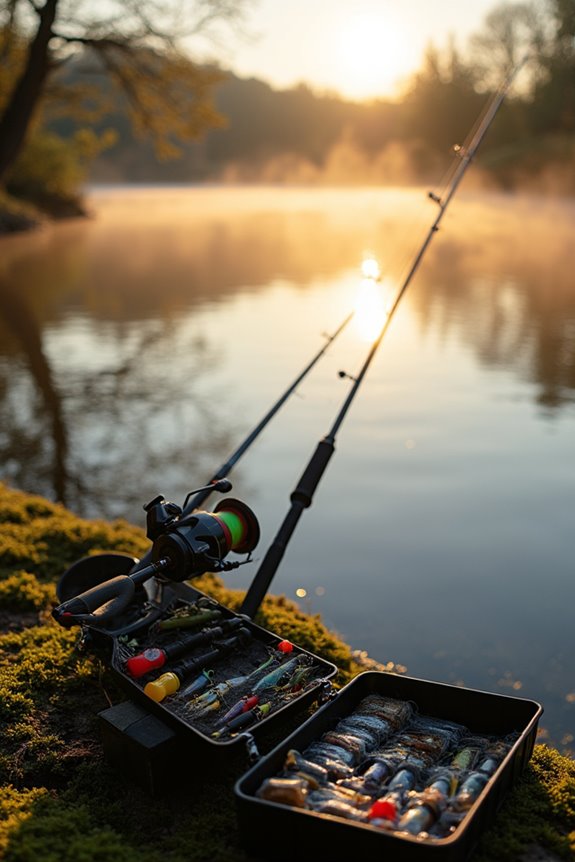To tie fishing lures securely, I recommend mastering key knots like the Improved Clinch Knot for hooks, the Palomar Knot for braided lines, and the Snell Knot for soft plastics. Use clean, fray-free line to guarantee strength, moisten before tightening to reduce friction, and maintain tight wraps. For topwater lures, consider the Rapala Loop Knot for better movement. Choosing the right knot enhances performance and catch rates, and there’s more valuable information to explore.
Key Takeaways
- Use the Improved Clinch Knot for securely attaching hooks or lures to monofilament lines.
- The Palomar Knot is ideal for braided lines, providing strength and reliability.
- For topwater lures, choose the Rapala Loop Knot to enhance movement and attraction.
- Employ the Snell Knot for soft plastic lures to improve hook exposure and alignment.
- Always moisten the line while tightening knots to reduce friction and ensure durability.
Understanding Fishing Knots
When you’re out on the water, understanding fishing knots is vital for successful angling. Knowing knot terminology helps you select the right knot for your line and lure. For instance, the Uni Knot is versatile, while the Palomar Knot is strong for braided lines. Each knot has a history, shaped by anglers’ needs for durability and performance. The Surgeon’s Knot excels at joining lines of different diameters, while the Snell Knot secures bait with ideal hook alignment. Finally, the Loop Knot allows for greater lure movement, essential for enticing fish. Having quality fishing line cutters will ensure clean cuts when tying these knots, preventing frustration and enhancing your overall fishing experience. Familiarizing yourself with these knots can enhance your fishing experience, ensuring that your tackle is secure and effective, regardless of your fishing conditions or target species.
Improved Clinch Knot
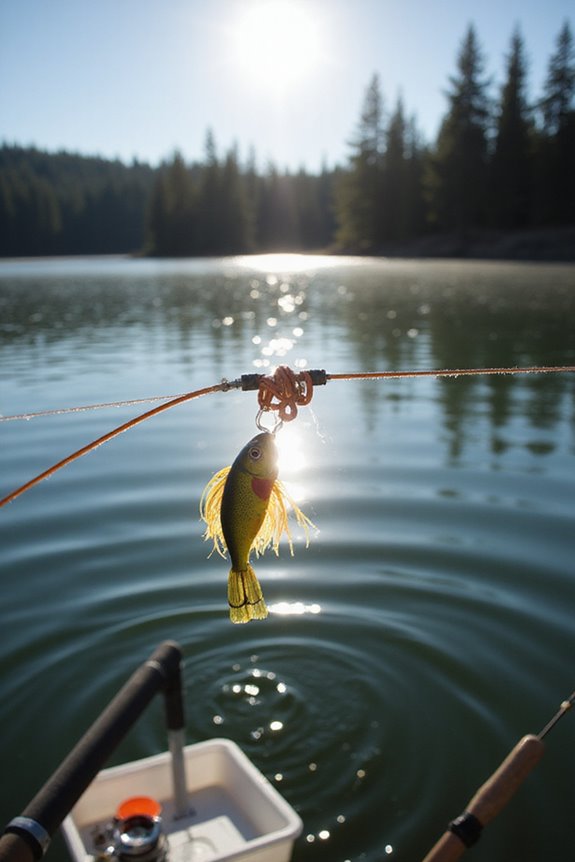
The Improved Clinch Knot is one of the most reliable knots I use for attaching hooks, lures, or swivels to my fishing line. It’s an enhanced version of the original clinch knot, designed to prevent slipping, making it suitable for both freshwater and saltwater fishing. I find it works best with monofilament and fluorocarbon lines due to their line compatibility. While not as strong as braided fishing lines with their superior strength-to-diameter ratio, it’s still highly effective for most fishing situations. To tie it, I pass the line through the eye, leaving about five inches of the tag end. Then, I wrap the tag end around the standing line five times. After that, I pass the tag end through the loop and then back through the larger loop. Always moisten the knot before tightening to guarantee strength and durability.
Palomar Knot
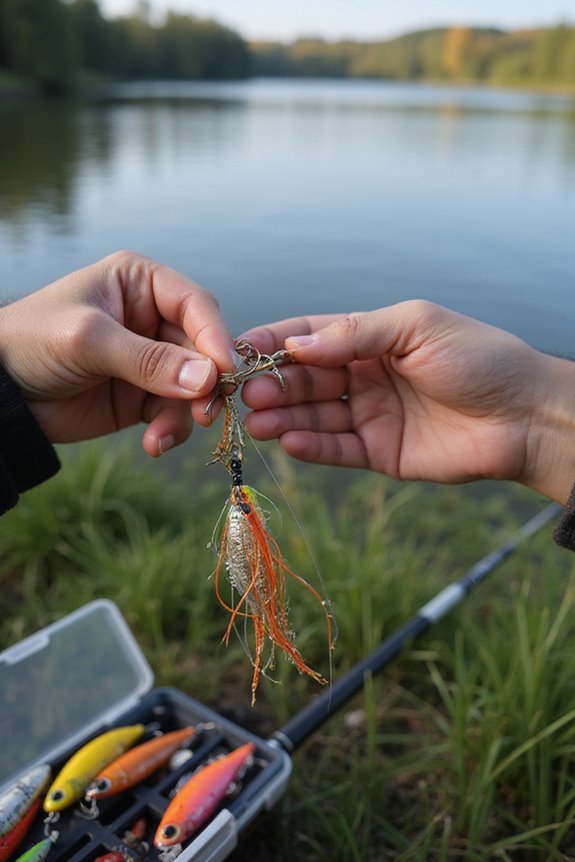
After mastering the Improved Clinch Knot, many anglers find themselves looking for alternatives like the Palomar Knot. This knot’s strength and reliability make it one of the strongest options for attaching a fishing line to a hook or fly leader. I recommend using it primarily with braided fishing lines, as it prevents slipping that can occur with other knot variations. To tie it, double your fishing line, pass the loop through the hook eye, and tie a simple overhand knot without tightening it. Make certain the loop is large enough for the hook to pass through easily. Don’t forget to lubricate the knot with water or saliva before tightening to maintain line integrity and guarantee a secure connection. For best results, consider keeping stainless steel pliers handy to help tighten the knot firmly without damaging your fingers or the fishing line.
Snell Knot
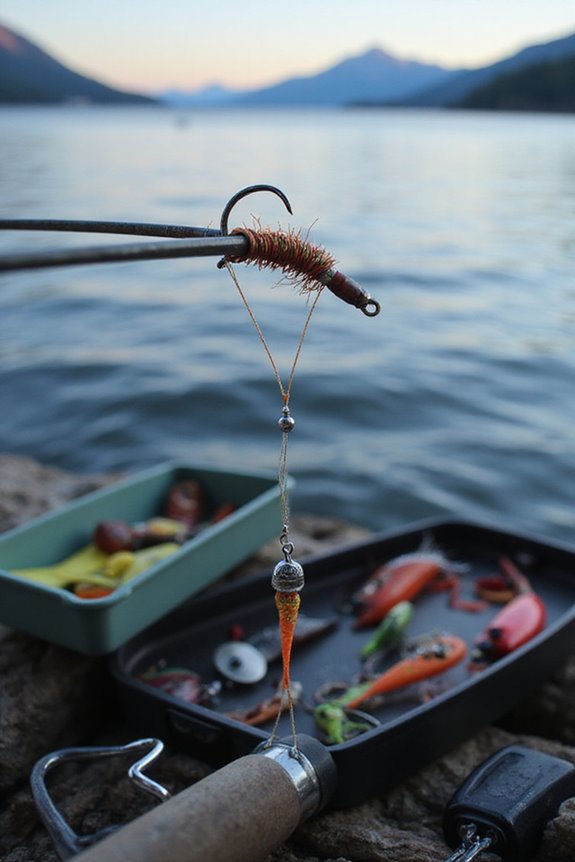
One effective knot you should consider in your fishing arsenal is the Snell knot. This knot’s benefits include improved hook exposure and angle control, especially in dense cover environments. It’s gained traction in bass fishing due to its efficiency when snelled and pegged against bullet weights. To tie it, pass the line through the hook eye, create a loop, and wrap the tag end around the shank several times. Make certain the line enters the hook eye from the front for proper alignment. There are Snell knot variations, including different loop sizes and wrap counts, which you can adjust based on your fishing needs. With practice, you can tie this knot in under 30 seconds, enhancing your rigging speed considerably.
Surgeon’s Knot
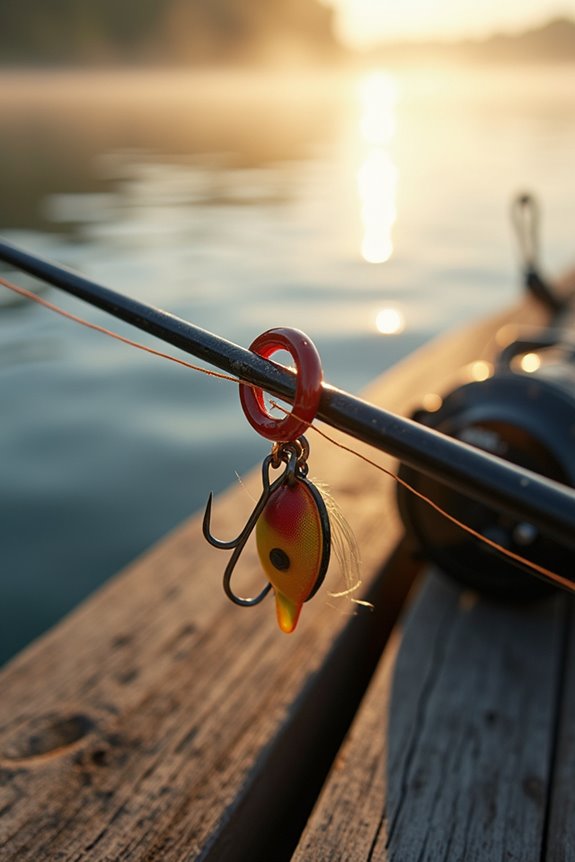
A Surgeon’s Knot is an essential skill for any angler looking to connect two lines effectively. This knot’s advantages include its strength and reliability, especially when joining lines of similar or different diameters. To tie it, overlap the tag ends of your lines by about 4 to 6 inches, then form a loop and tie a double overhand knot by passing the ends through the loop twice. Moisten the knot before tightening to avoid damage, and pull steadily on both ends. The surgeon’s knot applications are numerous; it’s ideal for tying a leader to a tippet or connecting sections of leader. This knot is particularly useful in heavy vegetation, where longer tag ends can trap weeds before reaching your lure.
Knot Strength and Performance
Understanding knot strength and performance is essential for success on the water. In my experience, performing a knot comparison between popular options like the Uni and Palomar knots can help determine which suits your needs best. The Uni knot retains about 88-92% of original line strength and is roughly 8% stronger than the Palomar knot, particularly with monofilament and fluorocarbon lines. Both knots offer great durability, but the Uni knot performs consistently well across different line types. I’ve found that the Palomar knot, while reliable, can lose about 12-14% strength, affecting its overall performance. Ultimately, choosing the right knot can make a significant difference in your fishing success, especially under high tension.
Choosing the Right Knot for Your Line
Choosing the right knot for your fishing line is essential to achieving peak performance on the water, especially when targeting specific species. First, consider line compatibility; monofilament, fluorocarbon, and braided lines each require different knots for maximum strength. For instance, the Palomar knot works well with braided lines due to its grip, while the Uni knot is versatile for monofilament. Next, assess knot durability; environmental factors like saltwater can weaken lines, so using robust knots like the FG knot can help. Additionally, think about your lure size; heavier lures necessitate stronger knots. Finally, practice tying these knots to guarantee you can adapt quickly while fishing, enhancing your overall success on the water.
Recommended Knots for Different Lures
When targeting various types of lures, selecting the appropriate knot can considerably affect your success on the water. For topwater lures, I recommend using the Rapala Loop Knot. This knot creates a secure loop, allowing the lure to move freely and mimic natural bait behavior, which can enhance strike rates.
When working with soft plastic lures, the Snell Knot is highly effective, especially for straight shank worm hooks. It offers a reliable hookset and improves alignment with the line, making it ideal for fishing in heavy cover. Both knots provide the necessary security and performance, ensuring your lures behave as intended and increase your chances of landing more fish.
Tips for Tying Knots Effectively
Tying knots effectively is essential for guaranteeing that your lures perform at their best, so it’s important to follow a few key practices. First, always use clean fishing line free of frays to guarantee knot strength. Keep the line moist during tightening to reduce friction and prevent damage. Choose a knot that matches your line compatibility, like the Palomar knot for braided lines. When wrapping, maintain tight, evenly spaced turns to enhance security. After tying, trim tag ends close to the knot but leave a tiny length to avoid unraveling. Don’t forget to check your knots with a firm tug test before casting. Regular practice will build muscle memory, improving your efficiency during fishing trips.
Frequently Asked Questions
How Do I Choose the Right Fishing Line for My Lure?
When I choose a fishing line for my lure, I consider the types available, like monofilament or braided. Line strength matters too, especially for the fish I’m targeting and the conditions I’ll face.
Can I Use a Knot for Saltwater Fishing?
In the wild dance of saltwater fishing, I’ve found that the right knot strength and saltwater resistance are essential. Trust me, mastering these knots can make the difference between a catch and a heartache.
What Materials Are Best for Fishing Lines?
When choosing fishing line, I prefer monofilament for its ease and flexibility, but fluorocarbon’s invisibility and abrasion resistance offer great advantages. Braid’s strength is impressive, though its visibility can be a drawback.
How Often Should I Check My Knots While Fishing?
Fishing’s like tending a garden; regular knot maintenance guarantees growth and strength. I check my knots often, especially under tension, to prevent unexpected failures. A swift inspection before each cast keeps my fishing fruitful and secure.
Can I Reuse Knots or Should I Tie New Ones?
I often think about knot longevity and integrity when deciding whether to reuse knots. If they’re visibly intact and not stressed, I might reuse them, but I usually prefer tying new ones for maximum reliability.

